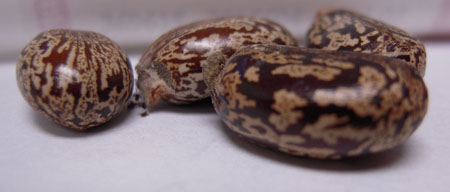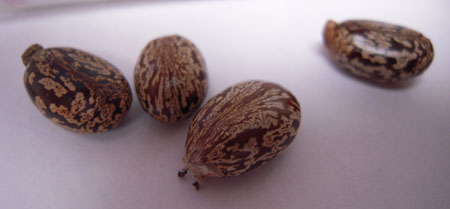诊断步骤
植物中毒后的表现完全取决于特定植物的摄入。 通常,需要摄入大量植物(或植物需要浓缩成提取物或发酵成茶)才能出现症状。 临床医生应该尽力识别相关植物,但治疗应关注表现出的症状,而不是关注摄入植物所引发的预计或预期后果。[2][33] 对摄入潜在有毒植物的无症状患者的评估应在摄入后观察数小时,并应尽力正确识别所摄入植物。 一些剧毒植物可能需要更严格的评估和观察(例如,毒芹、铃兰、秋水仙、嘉兰、鬼臼、相思豆、紫杉叶)。
病史因素
在历史上,确定植物摄入的量和摄入的途径,以及植物的类型都很有帮助。 例如,少量的乌羽玉就能产生神经毒性症状,然而大量的肉豆蔻才能产生相同的症状。 通常,当发现孩子们摄入植物,通常是小剂量摄入,且摄入的植物是已知的/可识别的。[1] 当成年人采摘/采集并食用野生植物时,通常是大剂量摄入,摄入的也是误识的植物。 当通过发酵或提取将植物浓缩物食用,剂量通常很大,这也是引起毒性的最可能的摄入途径。[1]
症状描述是非常重要的。
摄入美洲商陆、光滑冬青果、冬青浆果(通常≥6 个浆果)、槲寄生浆果、酢浆草或吐根的患者可能诉有胃肠道痉挛、呕吐和/或腹泻。
 [Figure caption and citation for the preceding image starts]: 冬青From private collection of Gerald O'Malley [Citation ends].
[Figure caption and citation for the preceding image starts]: 冬青From private collection of Gerald O'Malley [Citation ends]. [Figure caption and citation for the preceding image starts]: 冬青From private collection of Gerald O'Malley [Citation ends].
[Figure caption and citation for the preceding image starts]: 冬青From private collection of Gerald O'Malley [Citation ends]. [Figure caption and citation for the preceding image starts]: 冬青From private collection of Gerald O'Malley [Citation ends].
[Figure caption and citation for the preceding image starts]: 冬青From private collection of Gerald O'Malley [Citation ends]. [Figure caption and citation for the preceding image starts]: 酢浆草From private collection of Gerald O'Malley [Citation ends].
[Figure caption and citation for the preceding image starts]: 酢浆草From private collection of Gerald O'Malley [Citation ends]. [Figure caption and citation for the preceding image starts]: 酢浆草From private collection of Gerald O'Malley [Citation ends].
[Figure caption and citation for the preceding image starts]: 酢浆草From private collection of Gerald O'Malley [Citation ends]. [Figure caption and citation for the preceding image starts]: 酢浆草From private collection of Gerald O'Malley [Citation ends].
[Figure caption and citation for the preceding image starts]: 酢浆草From private collection of Gerald O'Malley [Citation ends].患者摄入蓝藻、千里光、其他千里光种、吊裙草、天芥菜属、苍术、卡瓦胡椒或绿茶胶囊后可能诉急性肝衰竭的症状(例如,皮肤发黄、精神错乱、记忆力差、人格改变和嗜睡)。
 [Figure caption and citation for the preceding image starts]: 千里光属From private collection of Gerald O'Malley [Citation ends].
[Figure caption and citation for the preceding image starts]: 千里光属From private collection of Gerald O'Malley [Citation ends]. [Figure caption and citation for the preceding image starts]: 千里光属From private collection of Gerald O'Malley [Citation ends].
[Figure caption and citation for the preceding image starts]: 千里光属From private collection of Gerald O'Malley [Citation ends]. [Figure caption and citation for the preceding image starts]: 千里光属From private collection of Gerald O'Malley [Citation ends].
[Figure caption and citation for the preceding image starts]: 千里光属From private collection of Gerald O'Malley [Citation ends].患者摄入草乌、铃兰、毛地黄、夹竹桃、红海葱、蓝升麻、毒芹、金链花、路单利草、羽扇豆、烟草、绿茶、巴拉圭茶、巴拉、麻黄、或阿拉伯茶后,可主诉心血管系统症状(例如,昏厥、头晕、呼吸短促、疲乏、心悸)。
 [Figure caption and citation for the preceding image starts]: 夹竹桃From private collection of Gerald O'Malley [Citation ends].
[Figure caption and citation for the preceding image starts]: 夹竹桃From private collection of Gerald O'Malley [Citation ends]. [Figure caption and citation for the preceding image starts]: 夹竹桃From private collection of Gerald O'Malley [Citation ends].
[Figure caption and citation for the preceding image starts]: 夹竹桃From private collection of Gerald O'Malley [Citation ends].摄入、吸嗅或吸入牵牛花种子、曼陀罗种子、罂粟籽、苦艾、大麻、古柯、乌羽玉(仅需少量)、美丽银背藤、肖美菊、鼠尾草、卡痛或极大量肉豆蔻的患者可能诉出现幻觉和/或意识模糊。
患者摄入草乌、山金车花、制川乌、马钱子、番木鳖、马钱属类种子、南美防己、南美箭毒树、黄花稔、杜鹃花、绊脚灌木、山月桂种、鼠李、coyotilla或洪堡鼠李后,可能诉四肢无力、麻木或疼痛。
患者摄入水毒芹、其他毒芹种、苦艾、苦艾酒、艾菊、鼠尾草、马钱子、番木鳖、马钱属类种子或八角茴香后,可能因出现癫痫发作来就诊。癫痫发作的特点是全面性发作肌肉痉挛和肌阵挛,伴有意识状态改变。
 [Figure caption and citation for the preceding image starts]: 毒芹From private collection of Gerald O'Malley [Citation ends].
[Figure caption and citation for the preceding image starts]: 毒芹From private collection of Gerald O'Malley [Citation ends]. [Figure caption and citation for the preceding image starts]: 毒芹From private collection of Gerald O'Malley [Citation ends].
[Figure caption and citation for the preceding image starts]: 毒芹From private collection of Gerald O'Malley [Citation ends]. [Figure caption and citation for the preceding image starts]: 毒芹From private collection of Gerald O'Malley [Citation ends].
[Figure caption and citation for the preceding image starts]: 毒芹From private collection of Gerald O'Malley [Citation ends]. [Figure caption and citation for the preceding image starts]: 毒芹From private collection of Gerald O'Malley [Citation ends].
[Figure caption and citation for the preceding image starts]: 毒芹From private collection of Gerald O'Malley [Citation ends]. [Figure caption and citation for the preceding image starts]: 苦艾From private collection of Gerald O'Malley [Citation ends].
[Figure caption and citation for the preceding image starts]: 苦艾From private collection of Gerald O'Malley [Citation ends]. [Figure caption and citation for the preceding image starts]: 苦艾From private collection of Gerald O'Malley [Citation ends].
[Figure caption and citation for the preceding image starts]: 苦艾From private collection of Gerald O'Malley [Citation ends]. [Figure caption and citation for the preceding image starts]: 苦艾From private collection of Gerald O'Malley [Citation ends].
[Figure caption and citation for the preceding image starts]: 苦艾From private collection of Gerald O'Malley [Citation ends]. [Figure caption and citation for the preceding image starts]: 蓝花鼠尾草From private collection of Gerald O'Malley [Citation ends].
[Figure caption and citation for the preceding image starts]: 蓝花鼠尾草From private collection of Gerald O'Malley [Citation ends]. [Figure caption and citation for the preceding image starts]: 蓝花鼠尾草From private collection of Gerald O'Malley [Citation ends].
[Figure caption and citation for the preceding image starts]: 蓝花鼠尾草From private collection of Gerald O'Malley [Citation ends]. [Figure caption and citation for the preceding image starts]: 蓝花鼠尾草From private collection of Gerald O'Malley [Citation ends].
[Figure caption and citation for the preceding image starts]: 蓝花鼠尾草From private collection of Gerald O'Malley [Citation ends]. [Figure caption and citation for the preceding image starts]: 八角茴香From private collection of Gerald O'Malley [Citation ends].
[Figure caption and citation for the preceding image starts]: 八角茴香From private collection of Gerald O'Malley [Citation ends]. [Figure caption and citation for the preceding image starts]: 八角茴香From private collection of Gerald O'Malley [Citation ends].
[Figure caption and citation for the preceding image starts]: 八角茴香From private collection of Gerald O'Malley [Citation ends]. [Figure caption and citation for the preceding image starts]: 八角茴香From private collection of Gerald O'Malley [Citation ends].
[Figure caption and citation for the preceding image starts]: 八角茴香From private collection of Gerald O'Malley [Citation ends].患者摄入喜林芋、五彩芋、醡浆草、白鹤芋、红辣椒或辣椒植物后,可能诉皮肤刺激或黏膜疼痛/灼烧感。
 [Figure caption and citation for the preceding image starts]: 酢浆草From private collection of Gerald O'Malley [Citation ends].
[Figure caption and citation for the preceding image starts]: 酢浆草From private collection of Gerald O'Malley [Citation ends]. [Figure caption and citation for the preceding image starts]: 酢浆草From private collection of Gerald O'Malley [Citation ends].
[Figure caption and citation for the preceding image starts]: 酢浆草From private collection of Gerald O'Malley [Citation ends]. [Figure caption and citation for the preceding image starts]: 酢浆草From private collection of Gerald O'Malley [Citation ends].
[Figure caption and citation for the preceding image starts]: 酢浆草From private collection of Gerald O'Malley [Citation ends]. [Figure caption and citation for the preceding image starts]: 辣椒From private collection of Gerald O'Malley [Citation ends].
[Figure caption and citation for the preceding image starts]: 辣椒From private collection of Gerald O'Malley [Citation ends]. [Figure caption and citation for the preceding image starts]: 辣椒From private collection of Gerald O'Malley [Citation ends].
[Figure caption and citation for the preceding image starts]: 辣椒From private collection of Gerald O'Malley [Citation ends]. [Figure caption and citation for the preceding image starts]: 辣椒From private collection of Gerald O'Malley [Citation ends].
[Figure caption and citation for the preceding image starts]: 辣椒From private collection of Gerald O'Malley [Citation ends]. [Figure caption and citation for the preceding image starts]: 辣椒From private collection of Gerald O'Malley [Citation ends].
[Figure caption and citation for the preceding image starts]: 辣椒From private collection of Gerald O'Malley [Citation ends]. [Figure caption and citation for the preceding image starts]: 辣椒From private collection of Gerald O'Malley [Citation ends].
[Figure caption and citation for the preceding image starts]: 辣椒From private collection of Gerald O'Malley [Citation ends].病人摄入黄花茅、零陵香豆、篷子菜、草木樨、红三叶草、或七叶树,可能主诉严重的出血症状。 出血可为可见的(如,鼻衄、黑粪症、阴道出血、血尿症、呕血、咯血、瘀点)或不可见的(如,头痛、精神状态改变、晕厥、呼吸短促、胸痛、腹痛或肌肉疼痛和肿胀),出血来源不同表现不同。
患者摄入秋水仙、番红花、长春花、北美鬼臼、鬼臼种、蓖麻子 (Ricinus communis) 或西非荔枝果后,可能诉与骨髓抑制有关的症状,表现为虚弱、呼吸短促、皮肤苍白、易发瘀斑、瘀点、腹痛、发热、皮疹和腹泻。
 [Figure caption and citation for the preceding image starts]: 蓖麻子From private collection of Gerald O'Malley [Citation ends].
[Figure caption and citation for the preceding image starts]: 蓖麻子From private collection of Gerald O'Malley [Citation ends]. [Figure caption and citation for the preceding image starts]: 蓖麻子From private collection of Gerald O'Malley [Citation ends].
[Figure caption and citation for the preceding image starts]: 蓖麻子From private collection of Gerald O'Malley [Citation ends]. [Figure caption and citation for the preceding image starts]: 蓖麻子From private collection of Gerald O'Malley [Citation ends].
[Figure caption and citation for the preceding image starts]: 蓖麻子From private collection of Gerald O'Malley [Citation ends].病人摄入、从鼻子吸入曼陀罗、疯草、颠茄、天仙子、或欧洲/原曼德拉草,可能主诉抗毒蕈碱症状(如,发热、皮肤干燥、皮肤发红、幻觉、无法排尿和呕吐)。[15]
病人摄入槟榔、卡拉巴豆、毒扁豆、和毛果芸香属植物,可能主诉毒蕈碱样症状(如,出汗、昏厥、头晕、气短、疲劳、心悸、腹泻)。[23]
病人摄入蓝升麻、毒芹、金链、路单利草、羽扇豆,或烟草,可能主诉剧烈呕吐、出汗、震颤、发热、心悸、癫痫发作、呼吸急促的症状。[9]
患者摄入木薯或李属植物后,[24] 可能主诉恶心、呕吐、腹痛、呼吸短促、过度通气,而且根据程度不同,可有头痛和意识状态改变。
体格检查
体格检查中的体征也很重要。
患者摄入蓝藻、千里光、其他千里光种属、吊裙草、天芥菜种、苍术、卡瓦胡椒或绿茶胶囊后可能有肝功能衰竭的体征(例如,黄疸、意识障碍、扑翼样震颤、腹水、肝掌、蜘蛛痣)。
 [Figure caption and citation for the preceding image starts]: 千里光属From private collection of Gerald O'Malley [Citation ends].
[Figure caption and citation for the preceding image starts]: 千里光属From private collection of Gerald O'Malley [Citation ends]. [Figure caption and citation for the preceding image starts]: 千里光属From private collection of Gerald O'Malley [Citation ends].
[Figure caption and citation for the preceding image starts]: 千里光属From private collection of Gerald O'Malley [Citation ends]. [Figure caption and citation for the preceding image starts]: 千里光属From private collection of Gerald O'Malley [Citation ends].
[Figure caption and citation for the preceding image starts]: 千里光属From private collection of Gerald O'Malley [Citation ends].患者摄入草乌、铃兰、毛地黄、夹竹桃、红海葱后,可能出现弱脉、心动过缓和/或低血压的症状。
 [Figure caption and citation for the preceding image starts]: 夹竹桃From private collection of Gerald O'Malley [Citation ends].
[Figure caption and citation for the preceding image starts]: 夹竹桃From private collection of Gerald O'Malley [Citation ends]. [Figure caption and citation for the preceding image starts]: 夹竹桃From private collection of Gerald O'Malley [Citation ends].
[Figure caption and citation for the preceding image starts]: 夹竹桃From private collection of Gerald O'Malley [Citation ends].病人摄入蓝升麻、毒芹、金链、路单利草、羽扇豆、烟草、绿茶、巴拉圭茶、巴拉、麻黄、酸橙、或阿拉伯茶,可能有心动过速和高血压表现。
患者摄入草乌、山金车花、制川乌、马钱子、番木鳖、马钱属类种子、南美防己、南美箭毒树、黄花稔、杜鹃花、绊脚灌木、山月桂属、鼠李、coyotilla 或 tullidora 后,可能在神经系统查体时出现无力和感觉减退。
病人摄入曼陀罗、疯草、颠茄、天仙子、或欧洲/原曼德拉草,可能有包括瞳孔放大(瞳孔散大)、发热、皮肤干燥、皮肤发红、心动过速和尿潴留在内的抗毒蕈碱样体征。[15]
患者摄入槟榔、卡拉巴豆、毒扁豆和毛果芸香属植物后,可能表现出毒蕈碱样体征,包括瞳孔缩小(瞳孔收缩)、出汗、心动过缓、低血压、听诊肺底部湿啰音。[23]
病人摄入蓝升麻、毒芹、金链、路单利草、羽扇豆、金链花,或烟草,可能表现出的体征有发汗、瞳孔放大、肌束震颤、发热、心动过速、高血压、呼吸抑制。[9][29]
检查
对摄入任何有毒植物的病人,心电图应该作为常规检查的一部分。
患者摄入草乌、铃兰、毛地黄、夹竹桃、红海葱、蓝升麻、毒芹、金链、路单利草、羽扇豆、绿茶、巴拉圭茶、巴拉、麻黄后,心电图可能显示心律不齐。
 [Figure caption and citation for the preceding image starts]: 夹竹桃From private collection of Gerald O'Malley [Citation ends].
[Figure caption and citation for the preceding image starts]: 夹竹桃From private collection of Gerald O'Malley [Citation ends]. [Figure caption and citation for the preceding image starts]: 夹竹桃From private collection of Gerald O'Malley [Citation ends].
[Figure caption and citation for the preceding image starts]: 夹竹桃From private collection of Gerald O'Malley [Citation ends].患者摄入草乌、铃兰、毛地黄、夹竹桃、红海葱后,心电图可能显示有或无心脏传导阻滞的心动过缓。
 [Figure caption and citation for the preceding image starts]: 夹竹桃From private collection of Gerald O'Malley [Citation ends].
[Figure caption and citation for the preceding image starts]: 夹竹桃From private collection of Gerald O'Malley [Citation ends]. [Figure caption and citation for the preceding image starts]: 夹竹桃From private collection of Gerald O'Malley [Citation ends].
[Figure caption and citation for the preceding image starts]: 夹竹桃From private collection of Gerald O'Malley [Citation ends].病人摄入蓝升麻、毒芹、金链、路单利草、羽扇豆、烟草、绿茶、巴拉圭茶、巴拉、麻黄、或阿拉伯茶,其心电图可能呈心律加快的表现。
患者摄入紫杉叶或种子后,心电图可能显示室性心律不齐。
 [Figure caption and citation for the preceding image starts]: 红豆杉From private collection of Gerald O'Malley [Citation ends].
[Figure caption and citation for the preceding image starts]: 红豆杉From private collection of Gerald O'Malley [Citation ends]. [Figure caption and citation for the preceding image starts]: 红豆杉From private collection of Gerald O'Malley [Citation ends].
[Figure caption and citation for the preceding image starts]: 红豆杉From private collection of Gerald O'Malley [Citation ends]. [Figure caption and citation for the preceding image starts]: 红豆杉From private collection of Gerald O'Malley [Citation ends].
[Figure caption and citation for the preceding image starts]: 红豆杉From private collection of Gerald O'Malley [Citation ends]. [Figure caption and citation for the preceding image starts]: 红豆杉From private collection of Gerald O'Malley [Citation ends].
[Figure caption and citation for the preceding image starts]: 红豆杉From private collection of Gerald O'Malley [Citation ends].
实验室检测
全血细胞计数 (FBC) 可帮助评估植物引起的骨髓抑制,或为内出血提供证据;血清电解质、尿素和肌酐可能有助于评估植物引起的肠胃炎/肾毒素。
对摄入含氰苷类植物后或植物引起的癫痫发作后的酸中毒评价,动脉血气和血清乳酸盐可能是有必要的。
摄入含强心苷植物后,血清地高辛水平可能呈阳性,但由于试验中亲和力差异,血清地高辛水平没有价值,要由症状严重程度决定治疗。 尽管摄入了强心苷,也可能出现阴性结果。
在摄入潜在肝毒性植物后,肝功能检查是有意义的。在摄入可能引起出血/肝毒性植物后,国际标准化比值是有意义的。
在摄入含可溶性草酸盐植物(大黄、酢浆草、dock、杨桃)后,血清钙水平可能下降。
在摄入生的西非荔枝果后,血糖水平可能下降。
肌钙蛋白可预测摄入秋水仙碱引起的心脏毒性。
有呼吸或心血管系统症状(如,气短、咳嗽、胸痛)的病人需要做胸部X线检查。
病人摄入槟榔、卡拉巴豆(ordeal bean)、或毛果芸香属植物,可发生非心源性肺水肿。 能否在胸部X线上表现取决于水肿的严重程度。
摄入可能的抗毒蕈碱样植物的病人对毒扁豆碱的反应。
毒扁豆碱是一种乙酰胆碱酯酶抑制剂,其持续时间很短(0.5-6小时),可在很短时间中逆转某些药物和毒素的抗毒蕈碱样作用。
当病人发热、心动过速和精神状态改变原因不明时,毒扁豆碱可在抗毒蕈碱样植物中毒中作为一种辅助诊断手段。 对毒扁豆碱的反应可以帮助鉴别抗毒蕈碱样中毒和其他原因(如感染或通过拟交感神经引起的中毒)引起的疾病。 毒扁豆碱可被用作治疗,并且在控制情绪激动方面,比苯二氮卓类更有效。[34]
植物鉴定
病人可能知道他们摄取的是哪些植物,他们甚至可能将植物(或植物的照片)拿给医生。 在这些情况下,当地中毒控制中心、大学、高校和植物园/苗圃/温室可以有助于鉴别植物。[1][35][36] 美国食品和药物管理局也对一个在线数据库进行维护,这个数据库可能会有帮助。US FDA: PLANTOX poisonous plant identification database 然而,通常情况是病人对植物的鉴定是错误的。 临床医生应注意,确定植物种类,但注意力应该放在所表现出的症状和体征上。
使用此内容应接受我们的免责声明。
